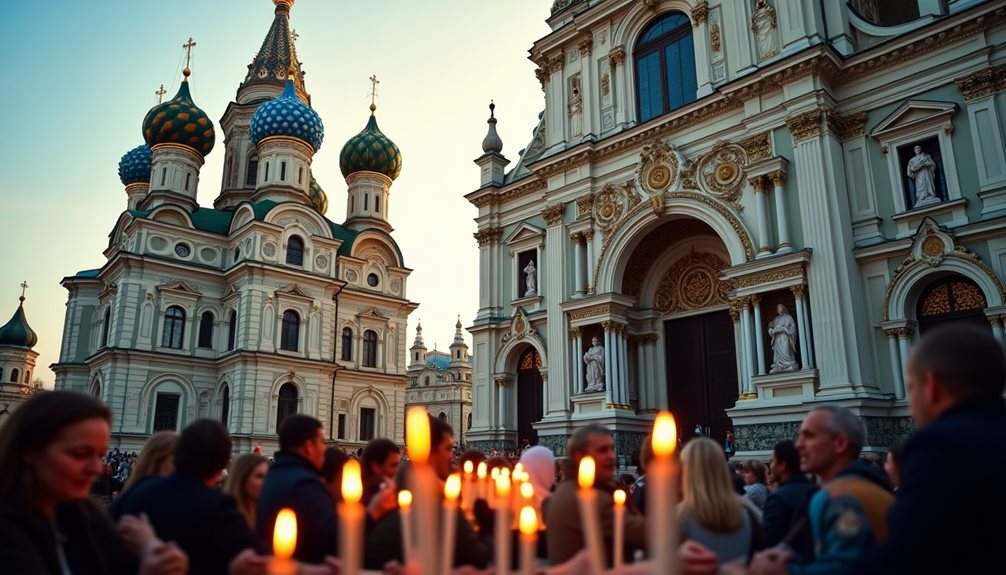Saint Petersburg, often heralded as the “Venice of the North,” is a region that seamlessly blends historical grandeur with modern liveliness. Its intricate network of canals and historic bridges tells a story of architectural brilliance while supporting a bustling port that drives significant economic activity. Beyond its economic prowess, the region’s rich cultural tapestry, from its diverse culinary scene to globally recognized festivals like the White Nights Festival, continues to captivate millions. However, what truly sets Saint Petersburg apart is not just its visible splendor but the deeper, often overlooked facets of its heritage and development.
Saint Petersburg: “Venice of the North”
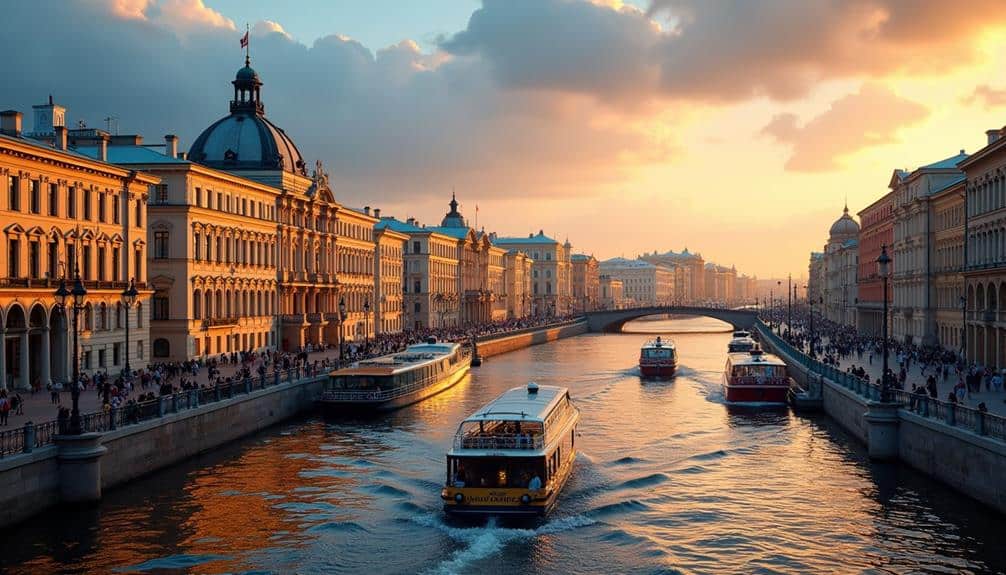
Often referred to as the “Venice of the North,” Saint Petersburg is renowned for its intricate network of canals, grand boulevards, and stunning architecture that evokes the charm and elegance of its Italian counterpart.
The city’s canal architecture is a reflection of its rich history and cultural heritage, with waterways crisscrossing through historic neighborhoods and under iconic, historic bridges. These bridges, such as the Palace Bridge and the Trinity Bridge, are not only functional but also artistic marvels, each telling a story of the city’s past.
Saint Petersburg is also a hub for cultural festivals that celebrate its artistic and historical significance. Events like the White Nights Festival captivate locals and tourists alike with performances and celebrations that light up the city’s long summer evenings.
Art museums, including the world-famous Hermitage, house vast collections that span centuries and continents, offering a feast for the eyes and mind.
The local cuisine of Saint Petersburg is as diverse as its history, featuring traditional Russian dishes alongside influences from Europe and Asia.
This culinary variety is best experienced in the city’s numerous cafes and restaurants, where the flavors of Saint Petersburg come alive, providing a true taste of freedom.
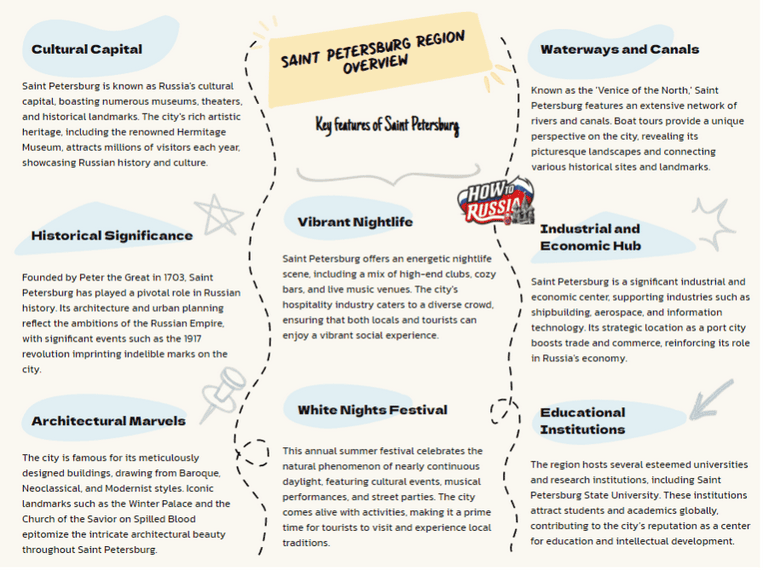
Interesting Facts About Saint Petersburg
Saint Petersburg, distinct in its allure and historical depth, offers a trove of fascinating facts that underscore its unique position in Russian and global history.
Known for its intricate transportation systems, the city boasts an extensive and efficient network of metro lines, buses, and trams that facilitate seamless urban mobility. This connectivity complements its unique architecture, which spans grandiose Baroque and Neoclassical styles, epitomized by landmarks such as the Winter Palace and the Church of the Savior on Spilled Blood.
Adding to its charm is the local cuisine, a delightful blend of traditional Russian dishes and international flavors. Visitors can savor borscht, blini, and pirozhki in cozy cafes and upscale restaurants alike.
The city’s vibrant nightlife further accentuates its dynamic character, offering an array of experiences from sophisticated theater performances to lively nightclubs and bars.
In comparison, Moscow, Russia’s capital, also features impressive transportation systems and iconic architecture, including the Kremlin and Red Square.
However, Saint Petersburg’s unique blend of historical depth, culinary diversity, and spirited nightlife sets it apart, making it a must-visit destination for those seeking freedom in exploration and cultural immersion.
Saint Petersburg Economic Landscape

The economic landscape of Saint Petersburg is robust and multifaceted, driven by a blend of traditional industries and modern sectors. The city is a vital hub for industrial sectors such as shipbuilding, manufacturing, and energy production. These industries have been the backbone of the region’s economy for decades, providing a stable foundation for growth.
Trade partnerships play an important role in Saint Petersburg’s economy, leveraging its strategic location near the Baltic Sea. The Port of Saint Petersburg is one of the largest in Russia, facilitating extensive maritime trade that bolsters economic activity. International trade relationships with Europe and Asia further diversify and strengthen the city’s economic portfolio.
Tourism also greatly impacts the local economy, attracting millions of visitors annually to its historic sites and cultural landmarks. This influx supports a wide array of businesses, from hospitality to retail, contributing substantially to the city’s revenue.
Workforce development remains a priority, with numerous educational institutions fostering a skilled labor force ready to meet the demands of both traditional and emerging industries.
However, economic challenges persist, including infrastructure modernization and global market fluctuations, which necessitate adaptive strategies to maintain economic resilience.
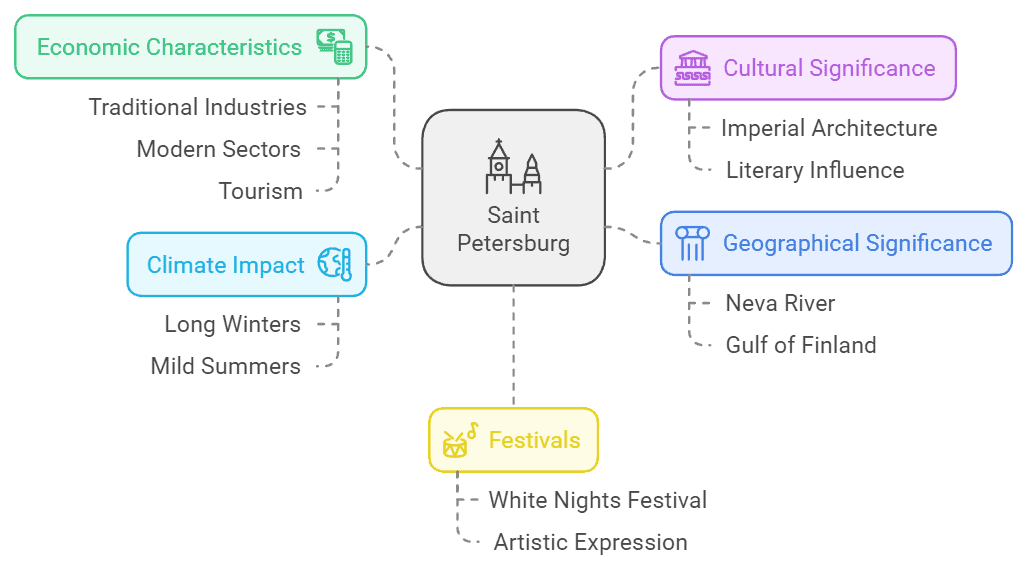
Culture and History of Saint Petersburg, Russia
Renowned for its rich cultural tapestry and storied past, Saint Petersburg holds a unique position as one of Russia’s most historically and artistically significant cities. The city’s imperial architecture is a reflection of its grandiose history, with landmarks such as the Winter Palace and the Peter and Paul Fortress reflecting the opulence of its tsarist era.
These majestic structures not only symbolize political power but also serve as cultural beacons, drawing visitors worldwide.
Saint Petersburg’s literary heritage is equally compelling, having inspired luminaries like Fyodor Dostoevsky and Alexander Pushkin. Their works, deeply interwoven with the city’s landscape, contribute to its identity as a cradle of Russian literature.
Cultural festivals, such as the White Nights Festival, further amplify the city’s artistic fervor by celebrating its music, dance, and theater traditions in a climate of creative freedom.
Significant historical events, from the Russian Revolution to the Siege of Leningrad, have profoundly shaped the city’s character, leaving an indelible mark on its collective memory.
Additionally, Saint Petersburg has been a hub for various artistic movements, including Russian avant-garde and socialist realism, making it a pivotal center for cultural innovation and expression.
Saint Petersburg Geographical Traits
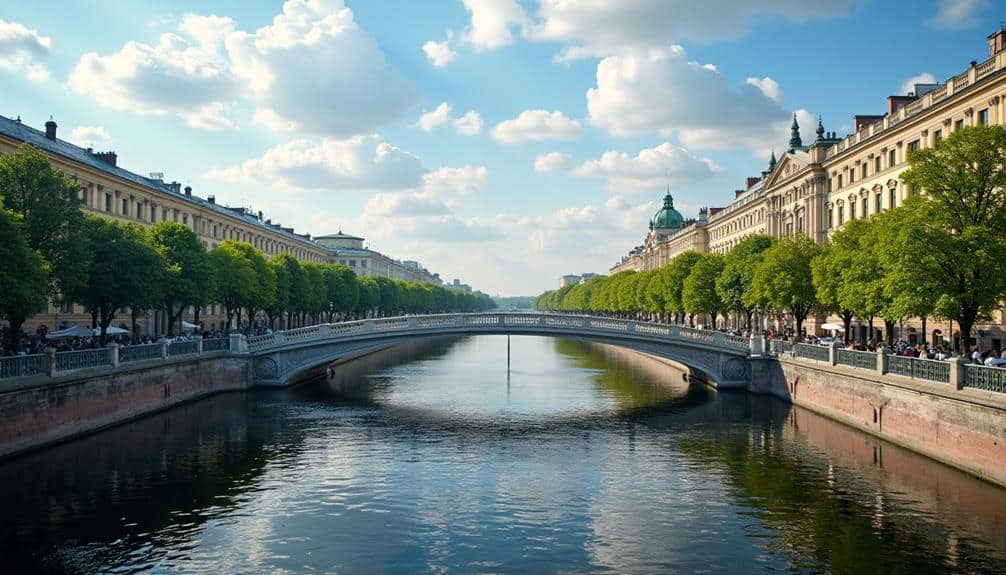
Nestled along the banks of the Neva River, Saint Petersburg boasts a unique geographical setting that has markedly influenced its development and character. This majestic city is woven together by an intricate network of river systems and canals, earning it the nickname “Venice of the North.”
These waterways not only define the urban layout but also enhance the city’s aesthetic appeal and accessibility.
The coastal geography of Saint Petersburg, positioned on the edge of the Gulf of Finland, adds another layer of charm and strategic importance. The city’s proximity to the Baltic Sea has historically facilitated trade and cultural exchanges, fueling its growth and cosmopolitan nature.
Natural landscapes, including sprawling parks and gardens, provide a serene contrast to the urban sprawl, offering residents and visitors alike a revitalizing escape.
Climate characteristics in Saint Petersburg are defined by long, harsh winters and brief, mild summers. Despite the challenges posed by its northern latitude, the city’s resilience is an indication of its enduring spirit.
The interplay of rivers, coastal geography, and climate conditions creates a dynamic environment that continues to shape the identity of this remarkable metropolis.


